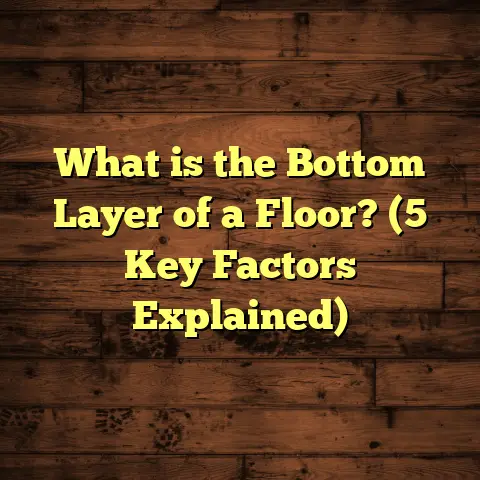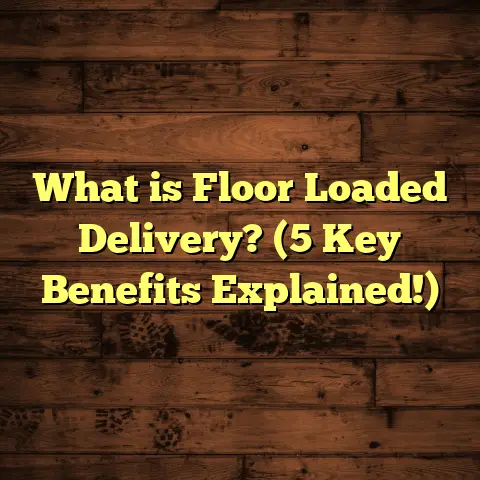What is Warehouse Flooring? (5 Essential Types Explained)
I remember the first time I stepped into a warehouse. The vastness of the space was both intimidating and fascinating. Stacks of boxes, machinery whirring, and the faint smell of fresh paint created a unique atmosphere. But what struck me the most was the flooring. It was sturdy, reliable, and essential for the daily operations happening all around me. I found myself wondering, what makes warehouse flooring so special?
If you’ve ever worked in or visited a warehouse, you probably noticed that the flooring isn’t just a surface to walk on; it’s a critical component of the overall functionality of the space. So, let’s unravel this mystery together and explore five essential types of warehouse flooring I’ve encountered throughout my years in the industry.
Concrete Flooring
Concrete flooring is often the first choice for warehouses, and it’s easy to see why. Its durability is unmatched, making it perfect for heavy machinery and foot traffic. After all, we’re talking about a surface that can withstand the weight of forklifts and pallets without flinching.
Durability and Maintenance
During one project, I watched as a client transitioned from an old wooden floor to a polished concrete surface. The difference was astounding! Not only did the polished concrete look sleek, but it also required minimal maintenance. A simple occasional sweep and mop were all it needed to keep it looking pristine.
Concrete’s resilience is impressive. According to industry standards, it can support loads of up to 20,000 pounds per square inch when properly mixed and cured. This makes it ideal for warehouses where heavy equipment operates daily.
Cost Considerations
In terms of cost, concrete typically runs between $2 to $6 per square foot, depending on whether you choose standard or polished finishes. And if you’re like me, you appreciate a good deal. That’s where FloorTally comes in handy. I’ve used it to get accurate cost estimates for my flooring projects, ensuring I stay within budget without sacrificing quality.
For example, I once had a client who was hesitant about investing in polished concrete due to costs. After demonstrating how FloorTally calculated potential savings over time—thanks to lower maintenance costs and exceptional durability—they were quick to move forward with the project.
Real-World Applications
Concrete flooring has been widely adopted in various warehouse settings. In one case study, a large distribution center in my area saw significant improvements after switching to polished concrete. They reduced their cleaning time by 50%, which translated into labor cost savings of thousands of dollars annually.
Furthermore, concrete can be customized with color additives or stains to enhance aesthetics without compromising functionality. This allows businesses to create a unique brand identity while maintaining an efficient workspace.
Epoxy Coatings
If you’re looking for something that adds both protection and aesthetic appeal, epoxy coatings are worth considering. These coatings are applied over concrete surfaces and provide a hard, glossy finish that’s easy to clean.
Unique Benefits
I recall a project where we coated the warehouse floor with epoxy to enhance safety. The glossy finish not only made it easier to see spills but also increased traction. The client reported fewer slips and falls after the installation, which definitely made my day!
Epoxy coatings typically contain two components: resin and hardener. When mixed, they create a chemical reaction that results in a durable surface that can withstand heavy traffic and resist chemical spills.
Statistics for Safety
According to the National Safety Council, slips and falls account for over 25% of workplace injuries. With an epoxy-coated floor, you’re not only improving aesthetics but also creating a safer environment.
In one instance, I worked with a manufacturing facility that dealt with oils and chemicals daily. After applying an epoxy coating, they reported a 30% decrease in accidents related to slips and falls within just three months!
Cost Insights
Applying epoxy coatings can range from $3 to $12 per square foot, depending on the quality of materials used and the complexity of the installation. While this may seem steep initially, the long-term benefits often outweigh the costs.
When I used FloorTally for this project, it helped me analyze upfront costs against future savings on maintenance and repair expenses. This way, my client could see the value in investing in high-quality epoxy coatings.
Vinyl Flooring
Now, vinyl flooring might not be the first option that springs to mind when you think of warehouses, but hear me out. It’s incredibly versatile and can handle various types of traffic while providing comfort underfoot.
Unique Benefits
I once worked with a client who needed a temperature-controlled area within their warehouse for sensitive materials. Vinyl offered excellent insulation properties and was easy to install over existing floors. Plus, it’s available in various designs that can suit different warehouse aesthetics.
Vinyl flooring also comes in different forms—tiles, planks, and sheets—allowing for customized installation based on specific needs. Its cushioned surface provides comfort for employees who spend long hours on their feet.
Cost Insights
Vinyl flooring typically costs between $3 to $7 per square foot. This makes it an affordable option for those who need durability without breaking the bank.
In one case, I had a client who initially wanted polished concrete but switched to vinyl after realizing its cost-effectiveness for their specific use case. Using FloorTally helped us compare costs side by side easily!
Real-World Applications
A notable example is a logistics company that chose vinyl flooring for their fulfillment center. They found that not only did it reduce noise levels from foot traffic but also provided a comfortable walking surface for employees during busy shifts.
Additionally, vinyl flooring is resistant to moisture, making it suitable for areas prone to spills or humidity—an important factor in many warehouse settings.
Rubber Flooring
Rubber flooring is another surprising contender for warehouse applications. It’s known for its shock absorption and slip-resistant properties, making it ideal for areas where employees are on their feet all day.
Anecdote
I remember a project where we installed rubber flooring in a loading dock area. The workers loved it! Not only did it reduce fatigue during long shifts, but it also provided excellent grip when moving heavy items.
Rubber flooring comes in various thicknesses and finishes, allowing you to choose based on your specific needs. In high-traffic areas where forklifts frequently operate, thicker rubber mats can provide additional protection against wear and tear.
Durability Statistics
Research shows that rubber flooring can last up to 20 years with proper maintenance, which is quite impressive compared to other options like vinyl or carpet tiles.
In one case study involving a busy warehouse environment, rubber flooring significantly reduced noise levels during peak operations—an often overlooked benefit that greatly improved employee satisfaction!
Cost Considerations
Rubber flooring typically costs between $4 to $10 per square foot, depending on thickness and quality. Although it may have a higher initial investment compared to other materials like vinyl or concrete coatings, its long lifespan often justifies the expense.
Using FloorTally for this project allowed me to show my client how investing in rubber flooring would potentially save them money in the long run due to reduced maintenance costs and extended durability.
Interlocking Tiles
For flexibility and ease of installation, interlocking tiles have become increasingly popular in warehouses. These tiles can be made from various materials such as rubber or vinyl and can be arranged in numerous patterns.
Flexibility in Design
I once had a client who wanted to create designated areas within their warehouse for different activities—like storage and employee break rooms. Interlocking tiles allowed them to customize their space easily without committing to one permanent floor type.
These tiles are especially beneficial for businesses that may need to adapt their layouts frequently or want to create temporary spaces without extensive renovations.
Cost Efficiency
Typically, these tiles range from $2 to $5 per square foot. They are an affordable choice for businesses looking to implement changes without major renovations.
In another instance, I helped a retail client who needed a flexible layout as they prepared for seasonal sales events. Interlocking tiles allowed them to rearrange their space quickly without disrupting operations!
Real-World Applications
A notable example comes from a tech company that utilized interlocking tiles in their shipping department. They found that being able to easily replace damaged tiles saved them time and money compared to traditional flooring options.
Moreover, interlocking tiles come in various designs and colors, allowing businesses to create visually appealing spaces while maintaining functionality.
Conclusion
Choosing the right flooring for a warehouse isn’t just about aesthetics; it’s about functionality, safety, and cost-effectiveness. My journey through various flooring options has shown me that each type has its merits based on specific needs.
I often recommend using tools like FloorTally that help calculate costs effectively and assist with budgeting. It’s been invaluable for me in managing projects smoothly and ensuring my clients are satisfied with their choices.
So, whether you’re renovating an existing space or setting up a new warehouse, consider these options carefully. The right flooring can transform not just the look of your warehouse but also its efficiency and safety.
What type of flooring do you think would work best for your space? Let’s chat about it!





